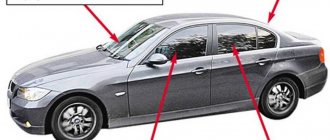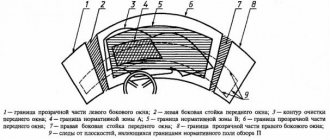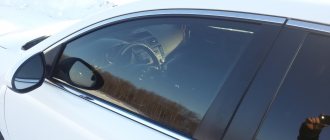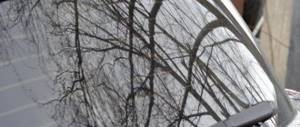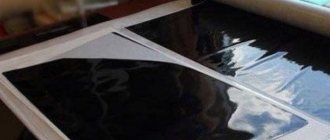For many, a car is not just a vehicle, but a separate world, so drivers strive to modernize the car to suit themselves and pay great attention to accessories and tuning elements. One of these is a tint film, which helps darken the standard windows and hide the interior from prying eyes. It has also gained popularity for the fact that it allows you to protect yourself from the bright sun and minimize the risk of fading of the upholstery inside the cabin. Drivers began using tinting back in the 80s. last century, and today it can be applied in almost any service. However, excessive tinting of windows on a personal car is prohibited in Russia, and in case of violation of the law, the traffic police inspector may issue a fine. They have fought against heavy tinting before, threatening arrest and confiscation of license plates, but today they are limited only to the imposition of administrative liability. You can find out what the fines for using tint film are in 2021 and whether it can be avoided by reading this article.
Content
- What tint is allowed?
- Acceptable glass tinting according to GOST
- Windshield tinting rules
- Acceptable tinting of the side windows of the first row
- Car rear window tinting
- Rules for tinting rear side windows
- Checking the car tint level
- Fines for illegal tinting
- How to avoid a fine for tinting your car windows?
- Questions and answers on the topic
What tint is allowed?
The light transmittance of the front and rear windows of a car is regulated by the requirements of GOST 32565-2013. This standard specifies the maximum percentage of shading for individual elements of the machine. In particular, the permitted tinting for the front and side windows of the car is indicated, and the size of the strip of color film applied to the top edge is determined. For violation of these requirements, the driver faces a fine established by part 1, clause 5, article 12 of the Code of Administrative Offenses of the Russian Federation.
If you decide to use car rear window tint film on your windshield or windshield, remember that elements with a mirror effect are completely prohibited. At the same time, GOST does not allow tinting or painting the windshield. The allowable reduction in light transmittance is provided to cover the difference created by the characteristics of the factory material.
Good tint glass: 16 questions about tinting
What is tinting?
A trivial question - a trivial answer: tinting (or tinting) glass - if outside the factory, then this means applying special materials to it - light filters that change its color and light transmission properties.
How is it done?
There are two ways to tint. One is to spray a thin layer of metal or polymer onto the inside of the glass. And the other is gluing the glass from the inside with colored films.
What does tinting do?
The first is, in fact, what it is done for - darkening the glass. The result is the creation of a more pleasant interior atmosphere in the car and less visibility of the interior from the outside, which is also important for many. At the same time, the darkened interior will fade less from the sun. Don't forget about the aesthetic component.
Finally, film tinting further strengthens the glass, preventing the formation of small fragments. This is especially useful when tinting domestic cars, the side windows of which are tempered and crumble into small crumbs in an accident. In sports cars, windows are often specially covered with a colorless film to strengthen them.
What can be tinted?
In the car, you can tint all the windows: windshield, rear and side, all optics: headlights and taillights, in addition – mirrors.
Do I need to remove the glass?
When tinting by spraying - it is necessary. When tinting with films, the glass is not removed. In some cases, it may only be necessary to dismantle decorative elements, linings and seals.
Is it possible to tint glass with heating filaments?
Can. High-quality film can withstand high temperatures and is not afraid of heating. Spray tinting is a complicated issue. Here it is possible for the material to shed along the heating filament due to the difference in the coefficient of thermal expansion.
How does tinting react to frost and heat?
High-quality tinting is not afraid of either extreme cold or extreme heat. Doesn't fade from the sun.
What does “high-quality” or “low-quality” tinting mean?
The quality of tinting is determined by two components: the material and the execution of the work, on which the result ultimately depends. The glass must be completely covered, without any light stripes around the edges. No bubbles, peeling or film creases. The color should be the same everywhere. There should be no optical distortions or rainbow stains.
How long does tint last?
The stations offer a guarantee of 1 to 2 years on average. But in practice, a well-made tinting can last much longer before abrasions and scratches begin to appear on it.
How much does tinting cost?
Depending on the car - glazing area and glass configuration, the average cost in St. Petersburg ranges from 5 thousand to 12 thousand rubles per car.
Are there many color options?
When tinting with film, the number of options is very large. The range of colors and variations is almost impossible to count. There are blue-violet, smoky, greenish, brown and other tones. There are films with a mirror effect, some two-color, some with a pattern.
Who makes tint films?
Well-known manufacturers include brands such as Johnson, LLumar, SunTec.
Can I do the tint myself?
Spray tinting is not possible, as special equipment is required. Film tinting is theoretically possible. But, as mentioned above, for a high-quality result, skill in tinting work and knowledge of the nuances are required. So it won’t work out quickly and simply, and at the same time look good.
Is it possible to remove the old tint without damaging the glass?
You can - this is called detonation. When tinting with films, you can always remove the old one. When this is done at the station by “soaking” with a special reagent, the glass is not damaged in any way and its transparency does not suffer. When tinting by spraying, this is a question: most of the sprays are such that they cannot be removed without harm to the glass.
Is tinting permitted by the Road Traffic Regulations?
The following follows from clause 7.2 “List of malfunctions and conditions under which operation of the vehicle is prohibited” and the requirements of GOST 5727 88. If there are both exterior mirrors, then the tinting on the rear windows (including the side windows) can be of any color and intensity - even paint them over. But in front - in the so-called. driver's visibility area - the light transmission of the glass must be at least 75% on the windshield and 70% on the front side windows. Mirror effect is not allowed here. It is believed that the factory glass itself initially absorbs about 20%.
Therefore, to comply with the Rules, only very “light” tinting can be done on the front. Or, if the factory windows are already darkened from the start, abandon it completely. And in any case, there is always a question: how to “catch” these percentages and not leave GOST.
An honest station should always provide responsible advice on the issue of tinting the front end. And if there is no possibility for tinting, they will not impose it.
Who will check?
The whole point of a possible problem is not in passing the technical inspection or in the claims of the traffic police inspector. The insurance company will definitely pay attention to the correctness of the tint when the question of insurance payment arises. And if the insurer’s examination recognizes that the tinting is not in accordance with GOST, payment will be refused on absolutely legal grounds.
Acceptable glass tinting according to GOST
Permitted tinting 2021 provides different levels of light transmission for individual car windows. When choosing film density, you need to remember the requirements of GOST, and also that even in a new car it is impossible to achieve 100 percent transparency. If the machine has been in operation for several years, then the light transmittance cannot exceed more than 90 percent.
Windshield tinting rules
According to the law, based on GOST requirements, car glass that provides forward visibility must have a light transmittance of at least 75 percent. The safety of the driver and passengers on the road, as well as the life and health of other road users, depends on this. GOST allows the use of a colored transparent strip on the windshield for protection from the bright sun. Its width should not be more than 14 cm.[1]
Acceptable tinting of the side windows of the first row
Permitted tinting of front windows in 2021 provides for at least 70 percent of light transmission. This means that darkening the sides is allowed no more than 30 percent.
Car rear window tinting
The law and the current version of GOST allow rear windows to be darkened, provided that external rear-view mirrors are installed on the sides of the car. In this case, the percentage of tint is not standardized. If the vehicle does not have mirrors, the light transmittance should remain at 70 percent.[2]
Rules for tinting rear side windows
GOST allows the use of tinting of any density on rear side windows. An important condition that must be observed when choosing a tint film for a car is that it should not have a mirror effect. This is not directly prohibited by the Code of Administrative Offenses of the Russian Federation, but is not permitted by the technical regulations of the Customs Union, adopted by all participating countries.[3]
Selecting material for tinting
There are several ways to darken car windows, but for tinting yourself it is better to use the film method.
It is important to know how to properly stick the film and what material is best to choose. The film can be:
- simple, with a black adhesive base;
- multi-colored;
- transparent, having various patterns;
- metallized, with different levels of darkening;
- with a changing color scheme;
- “chameleon” with a mirror surface;
- silicone;
- perforated.
The quality of the tint and its service life will depend on the tinting material.
By watching the video you will learn more about the species:
A little more effort will be required to tint glass with rolled material, since you need to cut it yourself. The cost of such material depends on the density and level of darkness. The color range is presented in a wide range, so there is an opportunity to choose for every taste.
Roll tinting material has the following advantages:
- dense structure;
- strength;
- resistance to mechanical damage;
- ease of gluing;
- ease of removal.
Tinting material comes in the form of a roll (click to enlarge).
This material is called removable tinting, since the glass underneath remains unchanged and such tinting can be re-glued as much as you like.
Removable tinting is produced in a standard length, and one roll is enough to cover all car windows.
When choosing a film, it is necessary to take into account its light transmittance. Windshield tinting must transmit at least 50% of light. The film covering the front side windows must have a throughput of at least 35%, the rear side windows and trunk - 15%.
A separate issue is the headlights. Can they be tinted? Tinting can be applied to the front and rear headlights only if the color of their glow and light transmittance are preserved. With headlights tinted in any other way, there is a chance that you will fail inspection and receive a fine.
Checking the car tint level
To measure the light transmission of side windows, rear or front windows, traffic police inspectors use special certified instruments. At the same time, the GOST requirements do not specify any requirements for the environmental conditions under which the percentage of density of the tint film can be checked[4]. In fact, this document allows the traffic police officer to take measurements even in a downpour, and at the same time his actions will remain within the law. The readings from the device for checking tinting are entered into the protocol by the traffic police officer. Without compliance with this requirement, no fine can be imposed for violating GOST rules. During the inspection, the driver has the right to ask the employee for a certificate for the device. It is important to ensure that no films or other elements are attached to the sensors when taking measurements. If the driver does not agree with the results of checking the level of tinting of the front or side window on his car, he can ask the employee to re-analyze the percentage of light transmittance in the presence of two witnesses. [5] In a garage environment, it is also possible to determine the approximate percentage of light transmittance. To do this, you need to know the density of the film and the condition of the car glass itself. As a check, the light transmission coefficients of these elements are multiplied and divided by 100 percent. Example: 75*90/100 = 67.5 - permitted tinting for rear windows. You can learn how light transmittance is checked in practice from this video:
Car tinting: how to avoid getting a fine
But it is important not to forget that the degree of tinting of car windows is regulated by GOST, and there are fines for excessive tinting. According to visibility requirements, coatings cannot be applied to car windows that restrict visibility from the driver's seat. The degree of toning should be such that the perception of white, yellow, red, green and blue colors is not disturbed. And glass that has a coating with a mirror effect is completely prohibited from being used on a car.
According to GOST, the degree of light transmission of the front side windows should not fall below 70%. The same criterion for the windshield is at the level of 75%.
Punishment for violating the light transmission parameters of glass is provided for in Part 3.1 of Article 12.5 of the Code of Administrative Offenses of the Russian Federation. It says that “driving a vehicle with glass installed (including those covered with transparent colored films), the light transmission of which does not meet the requirements of the technical regulations for ensuring visibility” is punishable by a fine of 500 rubles.
As you can see, GOST requirements apply only to tinting on the windshield and side windows of the car, and there are no restrictions regarding the degree of shading of the side windows of the second row and rear window.
A traffic police officer must check the degree of light transmittance of car windows using a special device. And during such a check, the driver has the right to demand a certificate for the equipment and make sure that it is correctly sealed. In addition, the driver can challenge the results of the first check and demand a second check of the glass in the presence of two witnesses.
Along with a fine of 500 rubles for violating the tinting, the motorist receives from the traffic police officer an order according to which the violation must be corrected within 10 days.
If the driver does not bother to remove the illegal tinting from the windows of his car and is caught again by the inspector, then the court may impose on the violator either a fine of 1,000 rubles, or punish him with 15 days of arrest for failure to comply with the requirements of the traffic police officer. However, if a motorist is ready to correct the violation on the spot at the first stop, then he can avoid even the first fine of 500 rubles.
Let us add that you can only remove a special tinting film, and when tinting with spraying you will have to replace the glass itself. In order to remove the film, you need to act carefully so as not to damage the surface of the glass. This risk exists if the film was applied a long time ago or already has some damage. The best solution in this case is to turn to professionals and remove the film at a car service within 10 days.
Fines for illegal tinting
If during the inspection it turns out that the darkening of the windows on the car exceeds the percentages established by law and GOST, the traffic police officer can issue an official report. The fine for illegal use of tinting is 500 rubles.[6] If the driver has already been caught violating GOST requirements, paid the issued fine, but did not remove the tint film, the traffic police officer has the right to issue a protocol for a new penalty in the amount of the same 500 rubles.
How to avoid a fine for tinting your car windows?
If, during the inspection, the traffic police inspector imposed a fine on the driver of the car for excessive darkening of the standard windows, this order, like any other, can be appealed in the standard manner provided for by the current law. However, it is worth remembering that to check light transmission, traffic police officers use a special device that has passed the appropriate certification. Therefore, it is almost impossible to prove to higher authorities that the equipment incorrectly determined the degree of darkness. If you were stopped by a traffic police inspector and during the inspection discovered a violation of GOST requirements regarding window tinting, you need to get rid of the tint film. By doing this immediately on the spot, you can even avoid an unwanted fine. To remove the tinting from the windshield, rear standard glass or side windows yourself, as directed by the traffic police officer, just pick up its edge and pull it up. The canvas should move away from the surface. If the tint film is of poor quality or has been glued to the glass for a long time, pieces of it or glue residue may remain on them. You can get rid of such defects using a soap solution and a special blade. Therefore, if you are not sure that you can quickly and easily remove the tint film from the rear or front standard windows on your own, it is better to contact a specialized service. There is a legal period of 10 days for this. If the tinting is done by spraying, then getting rid of it will be even more difficult. In this case, all glass that is not darkened according to the rules must be completely replaced. You will learn how to remove the tint film yourself from this video:
How to glue tint
First you need to prepare film blanks corresponding to the size and shape of the glass.
Cutting the film to the shape of the glass with a small allowance of 5-10 mm can be done directly on the glass. You need to spray water on the glass and apply a film that should stick to the wet glass. Moving the film over the surface of the glass, we install it so as to obtain minimal waste. Now you can carefully cut the film with a sharp knife along the contour of the glass, leaving the specified margin. When cutting out the film, you need to be extremely careful not to accidentally cut it in the wrong place or scratch the paint on the doors. In order not to risk the tinting film once again, you can first make a pattern from ordinary film or tracing paper, and then use scissors to cut blanks from the tinting film using scissors
After the blanks are cut and prepared, you need to thoroughly wash the tinted glass on the inside, where you are going to glue it, with glass cleaner.
The main secret of tinting masters at service stations is the product that they spray on the glass before gluing the tinting film. Without it, car window tinting is not as smooth and flawless. This product is intended to temporarily neutralize the effect of the adhesive base of the tinting film until it finally takes its place on the glass. The miracle remedy is a 10-20 percent shampoo solution, which you can prepare yourself and pour into a spray bottle.
Video: DIY tinting
Using a spray bottle, you need to cover the surface of the glass with a continuous layer of shampoo. Peeling off the protective coating of the film from one of the upper corners, stick this corner to the corresponding place on the glass
Pressing the tint onto the glass, carefully pull out the entire protective layer of film from under it. The operation can be done slowly, since the adhesive base is neutralized with shampoo for 20-30 minutes
After the protective layer of the film is completely removed, the film itself remains stuck to the glass and moves freely. You need to finally fix its position and start gluing the tint to the glass.
In order for the film to stick, you need to remove shampoo and air bubbles from the contact space. This procedure is performed by smoothing the film onto the glass using a sticker, starting from the middle to the edges. Air bubbles are clearly visible on the outside of the glass in the form of white spots. The shampoo solution, squeezed out along with the bubbles, is removed with dry wipes. The remainder of the film along the edges of the glass is cut off with a knife, not reaching 1-2 mm to the edge, with the exception of the lower part. At the bottom, the film is cut with an excess of 2-5 mm, which is tucked under the sealing rubber so that the edges of the tinting do not ride up when the glass moves down.
After finishing work, the film must dry for at least 24 hours. During this time, you must not touch the windows, lower them, or turn on the heating. The adhesive base of the tint, gradually drying, will reliably fix the film on the surface of the glass.
How to glue tinting to the rear window if its bend prevents the film from being evenly distributed?
In this case, you can apply the film in separate 2-3 strips. You need to start gluing the strips from the top, allowing overlap along the electric heating lines of the glass. Carefully cut and remove excess film exactly along the heating line so that the joint remains invisible. Gently iron the strips with a rubber spatula, removing excess water and air.
Questions and answers on the topic
Is tinting allowed in Russia?
Excessive tinting of car windows is illegal. The permissible percentages of light transmittance are reflected in GOST. Dimming the front window and side windows is permitted only within the prescribed values.
Do all types of glass have the same tinting requirements?
GOST adopted by law establishes different levels of minimum light transmission. For example, the shading of the front side windows should not be higher than 30 percent, and for the second row the shading level is not regulated at all.
What is the fine for tinting in 2021?
If a traffic police inspector during an inspection reveals that the permissible percentage of light transmittance is exceeded and does not comply with GOST adopted by law, the officer has the right to issue a fine in the amount of 500 rubles.
How to determine the level of tint?
To check the percentage of light transmittance, the traffic police inspector uses special certified devices according to the methodology described in GOST. It is more difficult to independently calculate the degree of tinting, but you can use a simple formula in which the light transmittance coefficients of glass and film are multiplied.
Types and features of two-layer tinting
You can tint in two layers in several ways:
Tinting using old film
If, for certain reasons, the car owner wants to update the tint, but does not want to remove the old film, you can stick a new film on top of the old one. At the same time, the old tint film must be in good condition - without scratches, clouding or peeling areas.
The “plus” of such tinting is that you do not need to dismantle the old film - this saves time and money. “Minus” is a strong darkening, which can exceed GOST.
Tint film on top of the sprayed layer
Tinting by spraying is not the cheapest “pleasure”, moreover, this type of tinting is almost impossible to dismantle. Often, to update the tint, car owners glue the film onto the sprayed tint layer.
This type of two-layer tinting has almost no disadvantages. The main thing is to follow the rules of pasting and do not forget to take into account the general level of shading of the glass.
Tinting with two films for a special effect
When you want to get a special effect, you can combine two films with different characteristics. For example, athermal film to reduce the level of heating of the interior and metallized film to reflect sunlight, UV and IR radiation.
Quite often, pasting with two films is used to obtain a beautiful visual effect - an unusual shade or iridescence. True, in this case, two films are rarely used. The range of modern tinting materials is so wide that every car owner can easily find exactly the option that will 100% meet his requirements.
